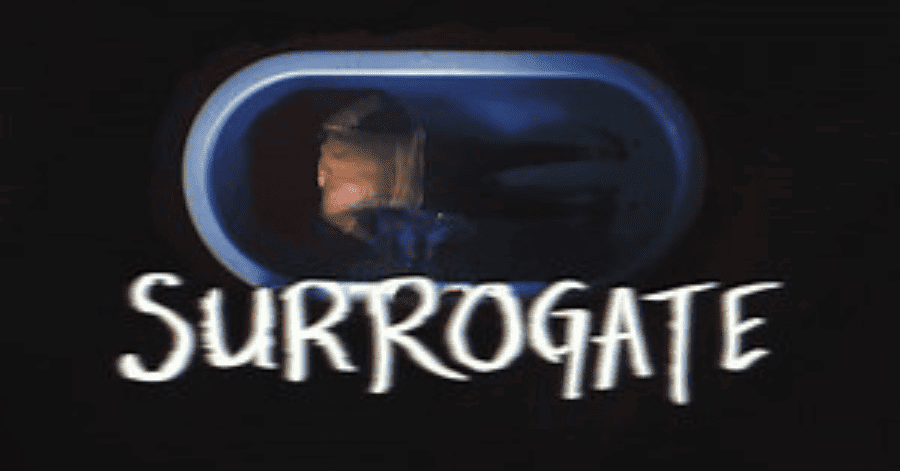I have written numerous blogs on the 3 Act Structure detailing Story Architecture – my Act By Act breakdown of the 45 elements your screenplay needs to fulfil the 3 Act Structure, be engaging, surprising, build coherently and express the complexity of your story and characters.
In this blog I wanted to show you how it can be a powerful tool to help write your next script by detailing how I used it to write my feature film Surrogate.
If you haven’t seen Surrogate yet the official website lists all the viewing options.
Surrogate was my 6th feature film screenplay, my 2nd in the horror genre and my 1st screenplay to make it into production. I won’t detail too much of how the screenplay came about as it’s covered in Birthing Nightmares: Making Surrogate.
I co-wrote Surrogate with Beth King commencing the process in 2016 and we wrote 4 major drafts over a 2 year period and had the story down by then. 4 more drafts were written over the subsequent 2 years, mostly tightening, polishing and dialogue tweaks.
Surrogate was influenced by Japanese and Korean horror films from the late 90’s including Ring, Grudge and Whispering Corridors. We used some of their story structure elements which revolutionised modern paranormal horrors, particularly the final act.
The script was also influenced by films such as The Exorcist, The Others and The Orphanage, which are all story based horrors. We wanted our script to stand as a piece of filmmaking and drama in it’s own right as well as a horror. We didn’t want to rely solely on gratuitous gore, don’t get me wrong, I love those types of horror films too but this wasn’t our intention with Surrogate, we needed the story and characters to work along with well as the horror elements.
Logline
A ghost horror about Natalie Paxton, a single mother and nurse who falls mysteriously ill and struggles to stop her family from being destroyed.
1. Introduce Protagonist
Opening image of the protagonist and what their current world and situation is.
Surrogate
The story opens on Natalie Paxton, her brother and mother (and dog Indie) singing happy birthday to her daughter Rose, who has just turned 9 years old. The family unit is together, having fun and celebrating a birthday. A birthday, the location of the living room and it’s design of clean, orderly and bright, all become crucial factors that will be referenced at the climax of the screenplay bookending it with the final image.
2. Create Empathy
To become emotionally invested in the story the audience needs to empathise with the protagonist.
Tricks to create empathy are: Misfortune, Power, They Are The Best, Humour, Other Characters Admire Them, Powerful.
Surrogate
Empathy is created for Natalie in a few key moments.
Relationship with her daughter.
Natalie has a great relationship with her daughter Rose, there is a love, warmth and care between the two of them. Natalie has an empathetic understanding of Rose’s fears when putting her to bed, despite telling her
“There is no such thing as monsters”
she allays Rose’s fears by searching the room to ensure there are no monsters.
Decisions under pressure.
Despite Natalie’s initial reluctance to help Margot when she is accosted by her in the isolated car park late in the night, in the subsequent scenes at the petrol station Natalie tries valiantly to save Margot’s life after she commits suicide.
Natalie not helping Margot initially can be perceived as a contradiction on how to create empathy for a character but as I detail in the 1-Step-A-Day Screenplay course, the genre of your story will dictate certain conventions specific to the genre you are writing. In all the best horror films the protagonist plays some part in their own demise, they need to contribute to the horror that comes into their life in some way.
The classic example of this is curiosity in The Ring, if the protagonist doesn’t search for then watch the mysterious VHS tape then she would never have crossed path with the horror, in Psycho if Marion doesn’t steal the $40,000 and elope to meet her boyfriend then she wouldn’t end up at Bates Motel and ultimately dead in her car submerged in a lake.
If Natalie assisted Margot initially she would not have brought about her own demise by allowing the suicide to happen and the evil being passed on.
Misfortune
Natalie collapses then awakens in hospital and is both physically vulnerable and emotionally fearful as she has suffered a mysterious and potentially life threatening condition.
Unfairness
Whilst Natalie is grappling with what is happening to her and trying to grasp that she gave birth without being pregnant, she then must defend herself when Child and Family Services accuse her of potentially killing a child she gave birth to.
3. Set Tone
If your screenplay is a Comedy – have some laughs, a Thriller – a race against time or risky situation, an Action – a chase or fight scene, a Horror – a scare, death or haunting.
Surrogate is a paranormal horror with mystery/crime elements.
The tone is set in a few key moments in Act 1.
Jump scare
In the second scene when Natalie is putting Rose to bed her brother Bill jumps from behind the bed and scares them both. Surrogate intentionally doesn’t operate solely on cheap jump scares to generate horror constantly, however almost all horror films have 1 or 2 as the audience expects and enjoys them. By having a jump scare early in the film that is defused by the fact it’s a prank warms the audience up for scares but they are quickly let off the hook as there is no consequence to this scare. As the story progresses the scares will escalate and have serious consequences.
Body horror
The arrival of Margot at the medical clinic ranting and appearing to suffer from mental illness serves two functions, the first it foreshadows later scenes in the film and secondly her brutal suicide by drinking engine chemicals is a genuine horror seen and introduces the tone of body horror which will be depicted in various ways in the film.
The body horror tone is followed up a few scenes later when Natalie wakes in the middle of the night bleeding followed by the ‘blood rush’ scene where litres of blood exploded from her. It’s a moment of visceral body horror solidifying the genre at the 12 minute mark of the story.
4. Introduce Theme
Is the story about Justice, Survival, Love, The American Dream?
Is the theme a question to be explored – Can men and women be friends?
A moral – Crime doesn’t pay!
Surrogate, like all horror stories, is about survival. On a deeper level and more specifically it’s about a family being torn apart and how far a parent will go to protect their child.
This theme is set up in the first scene of the film where the entire family unit is together and happy. The protagonist doesn’t know that with in days her life will start to fall apart and over the coming weeks her family will be ripped away from her.
This idea is solidified in a seemingly irrelevant, yet key set up scene where Rose says in a video diary for her school assignment about her family tree
“Most of my friends have brothers and sisters but I don’t have to share my mum with anyone else”.
5. Skills & Abilities
Show some of the specific skills or abilities the protagonist has that they’ll need later in the story.
Surrogate
Natalie is a nurse and her skill of performing CPR will be called upon a few times in the film.
It is first used when she tries to revive Mad Margot at the petrol station after she drinks poison and will be later used in the climax of the story.
When Natalie collapses and is rushed to hospital, despite being scared and confused about what is happening to her and her body she has an element of awareness that something greater is going on that can’t be explained yet. She is inquisitive and needs to have answers and a rational understanding of what is going on.
Through out the story she questions and investigates to try and uncover the truth, however to completely succeed she will have to jettison her need for logical answers and give herself over to an irrational explanation.
6. Introduce Antagonist
Opening image of them and what they doing.
Surrogate has duel antagonists, one grounded and rational and the other irrational.
The ghost of Lisa Bayer is the main antagonist who haunts Natalie but Natalie and the audience don’t realise they are introduced to Lisa in the third scene of the film.
Natalie gets in her car late at night after a long shift when Mad Margot accosts her, she rambles but periodically chastises someone who isn’t there. Later Natalie and the audience learn Margot isn’t crazy and that she’s chastising the evil spirit Lisa who is taunting her.
Lisa is present through the rest of Act 1 but unbeknownst to Natalie and the audience, firstly with the morning sickness Natalie suffers and then the rebirthing Lisa in the ‘Blood Rush’ scene late one night when Natalie awakes bleeding and in pain. When Natalie is recovering in hospital she is woken at night by Lisa crying which lures Natalie to the nursery.
To counter the irrational and hidden antagonist in Act 1 (and for the first half of Act 2) a grounded antagonist is included which is the social worker Lauren Balmer (Jane Badler).
This is a common technique in horror films where a person or people create antagonism for the protagonists as well as the ‘monster’. In Jaws it’s Quint, Alien Ash the android and Cooper in Night Of The Living Dead are grounded antagonist complicating the situation whilst the protagonist tries to fight the monster.
Whilst Natalie struggles to solve the mystery and protect her family she locks horns with Lauren who is suspicious of Natalies behaviour and believes she might be abusing Rose. This increases the stakes for Natalie as Lauren has the power to remove Rose from Natalie’s custody.
7. Inciting Incident
The event that throws the protagonists world out of balance which sets up the goal of the story they strive to achieve. From the inciting incident emerges the Dramatic Question which must be answered by the end of the story.
Surrogate
Natalie wakes in hospital to her mother and daughter waiting by her bedside. They are interrupted by Dr Romero and Lauren Balmer (Jane Badler) who works for Child & Family Services. They quiz her about the previous 24 hours and ask if she’s been to any other hospitals.
Natalie is confused but they push her harder about how she was pregnant. Natalie is amused at the absurdity but quickly becomes defensive when she realises they are serious. She insists that she wasn’t pregnant but Dr Romero responds that she wasn’t only pregnant but all physical signs indicate she went full term and gave birth to a baby.
Surrogate’s Dramatic Question is
What caused the mysterious birth and how will Natalie survive the subsequent haunting?
8. First Step
If the protagonist choose, are forced to engage or react to the inciting incident, what is the First Step they take to achieve their goal or solve their problem?
Surrogate
Natalie doesn’t take a first step until Act 2 and chooses avoidance initially.
9. Avoidance
If the protagonist doesn’t react or refuse to engage how and why do they do this?
As Natalie is in shock and fearful about what is happening to her body she initially chooses to avoid dealing with her problem and regresses to sleeping. She is awoken from that sleep by a mysterious crying baby that no one else can hear. She starts to sense something is very wrong with either her or in the world but tries to rationalise it.
In horror this event is known as ‘the first attack’ and the beginning of the protagonist having an inkling that something is wrong but as it’s relatively minor or it can be rationalised, they avoiding it in a hope that it will go away.
10. Introduce Supporting Characters
Introduce some of the supporting characters, though not all have to be introduced in Act 1.
Surrogate’s Act 1 introduces Natalie’s family who will support her, challenge her and then ultimately leave her life.
Natalie’s brother Bill plays two important functions in the story. A key component of Natalie’s character is a skeptic. She has a sense something is wrong but believes a rationale explanation exists, a common character trait and theme explored in paranormal horror films. Her brother Bill is a counter point and a voice of reason who forces Natalie to acknowledge the extent of the problem her and Rose are facing.
Bill’s other function in the story is introduced in Act 1 being the depiction of the great relationship he has with his niece Rose. This will be paramount in Natalie solving her problem at the story climax.
Natalies mother Anna provides her with various support early in the story, particularly as a babysitter whilst Natalie works. Later she provides refuge to Natalie and Rose when they escape their house after Rose is pushed down the stairs. However this decision brings about Anna’s death and through this loss Natalie can no longer run away from the danger in order to save her family, she must face it.
11. Subplot Scenes
Commence a subplot
Surrogate
The main subplot is social worker Lauren Balmer trying to determine if Natalie is in fact a child abuser or worse, a child killer.
12. First Set Back
What is the first set back the protagonist encounters in striving to achieve their gaol?
Surrogate
As Natalie hasn’t technically started to solve her problem in Act 1 the first set back is a lack of answers when Dr Romero tells her they have no idea what happened to her
“You’re a medical mystery”.
She is left at the end of Act 1 none the wiser to what is wrong with her but the extremely disconcerting words that her condition is ‘unheard of’ . As a result she’ll encounter set backs in Act 2 as she starts to determine what is happening to her.
13. Set Up Climax
Show any specific elements for the climax to work.
Surrogate employs a technique that I like very much in stories which is to plant a lot of information early in the screenplay that the audience don’t realise are significant until later.
Several components are set up in Act 1 of Surrogate that make the climax work.
The first scene opens on Roses 9th birthday, the climax of the film is on Roses 10th birthday and nothing about Natalies world remains the same.
In hospital Dr Romero quizzes Natalie about the sleeping medication she previously took sets up her decision on how to deal with having just given away her daughter.
Natalie also gives CPR to Margot but isn’t successful, in the story climax she will again perform CPR but on Rose and this time she MUST be successful.
Act 1 also sets up several key revelations for the 2nd Act Climax connected to Mad Margot when Natalie realises the true nature of what has really been going on and unlocks the mystery of Lisa Bayer. However, she is still wrong about an aspect which she’ll realise in the climax.
14. Backstory
What is part of the protagonists back story?
Surrogate
We get very little backstory in Act 1 except the vague reference that Roses father isn’t in her life when Lauren Balmer is quizzing Natalie in hospital. However Natalie doesn’t elaborate on the circumstances but there is a tinge of shame when discussing it. Repressed shame, regret, guilt or a secretive past are common elements for characters in horror films.
The other detail of her back story revealed when in hospital is Natalie was previously on sleeping medication but has cycled off it in recent years. In Act 2 she will return to using them to cope with her exhaustion and in the climax they will be potentially part of the solution to her problem.
15. Act 1 Climax
A point of no return, committing to the goal, a major set back, a major development, a revelation transition to new world – Is it positive or negative event?
Surrogate
The Act 1 Climax is the final scene in the hospital where Dr Romero informs Natalie he’s at a complete loss as to what has happened to her.
He says there are plenty of documented cases of women experiencing a phantom pregnancy but the fact she went through labour and gave birth makes her a medical mystery.
For Natalie she can no longer deny that she went through labour but she has no understanding of why. She is unaware that this is just the beginning and the repercussions are going to dominate Act 2 of the story.
Lauren Balmer informs her she’ll be doing a home visit to check up on Rose. Natalie has had enough of the hospital and despite still recovering she chooses to return back home.
The Act 1 Climax is a negative development.
Screenplay Method’s
Story Architecture: 45 Elements To Build A Great Screenplay
Story Architecture is David Willing’s technique to analyse, understand and write the 3 Act Structure.
It’s an Act By Act breakdown of the 45 elements your screenplay needs to fulfil the 3 Act Structure, be engaging, surprising, build coherently and express the complexity of your story and characters.
However it isn’t a strict formula, you don’t have to include all of the elements, some scenes may have multiple elements in them and they don’t have to appear in this order.
Here are the first 15 elements of Act 1. Importantly, to further explain these, I have broken down the film Apocalypse Now into this format.
Act 2 and 3 are available in my 1 Step-A-Day training program. For more information please visit Screenplaymethod.com. You can use the discount code “SPM100” for a special $100 discount.





